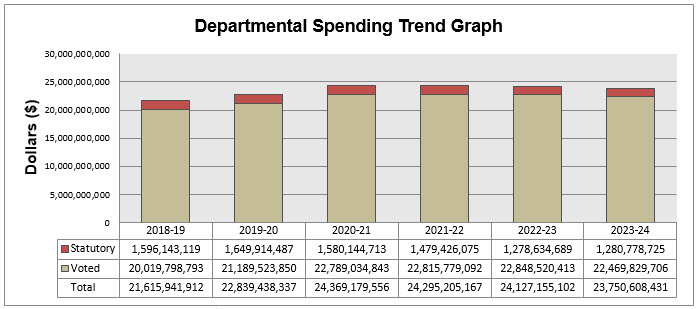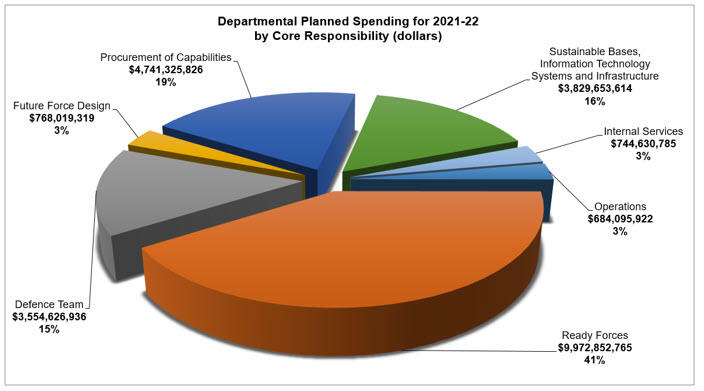Spending and human resources
This section provides an overview of the department's planned spending and human resources for the next three consecutive fiscal years and compares planned spending for the upcoming year with the current and previous years' actual spending.
Planned spending
Departmental spending 2018-19 to 2023-24
Departmental spending trend graph
The following graph presents planned (voted and statutory) spending over time.

Description of Figure: Departmental Spending Trend
This bar graph depicts Defence's financial spending trend starting with fiscal year 2018-19.
On the Y-axis are dollars ranging from 0 to 30,000,000,000. On the X-axis is Fiscal Year 2018-2019 through 2023-2024.
Statutory Financial Spending Trend is:
- $1,596,143,119 in 2018-19;
- $1,649,914,487 in 2019-20;
- $1,580,144,713 in 2020-21;
- $1,479,426,075 in 2021-22;
- $1,278,634,689 in 2022-23; and
- $1,280,778,725 in 2023-24.
Voted Financial Spending Trend is:
- $20,019,798,793 in 2018-19;
- $21,189,523,850 in 2019-20;
- $22,789,034,843 in 2020-21;
- $22,815,779,092 in 2021-22;
- $22,848,520,413 in 2022-23; and
- $22,469,829,706 in 2023-24.
Total Financial Spending Trend is:
- $21,615,941,912 in 2018-19;
- $22,839,438,337 in 2019-20;
- $24,369,179,556 in 2020-21;
- $24,295,205,167 in 2021-22;
- $24,127,155,102 in 2022-23; and
- $23,750,608,431 in 2023-24.
Budgetary planning summary for Core Responsibilities and Internal Services (dollars)
The following table shows actual, forecast and planned spending for each of the Department of National Defence and the Canadian Armed Forces' Core Responsibilities and to Internal Services for the years relevant to the current planning year.
| Core Responsibilities and Internal Services | 2018–19 Expenditures | 2019–20 Expenditures | 2020–21 Forecast spending | 2021–22 budgetary spending (as indicated in Main Estimates) | 2021–22 Planned spending | 2022–23 Planned spending | 2023–24 Planned spending |
|---|---|---|---|---|---|---|---|
| Operations | 1,424,919,741 | 1,044,514,772 | 1,234,062,592 | 684,095,922 | 684,095,922 | 688,988,747 | 703,688,999 |
| Ready Forces | 9,506,982,585 | 9,875,229,209 | 9,691,638,940 | 9,972,852,765 | 9,972,852,765 | 10,096,532,908 | 10,296,558,574 |
| Defence Team | 2,779,583,406 | 3,365,827,143 | 3,464,887,060 | 3,554,626,936 | 3,554,626,936 | 3,591,485,901 | 3,681,978,625 |
| Future Force Design | 845,573,026 | 758,767,328 | 831,230,791 | 768,019,319 | 768,019,319 | 779,337,759 | 795,850,417 |
| Procurement of Capabilities | 3,069,157,738 | 3,298,055,560 | 4,435,750,335 | 4,741,325,826 | 4,741,325,826 | 4,310,164,815 | 3,538,411,344 |
| Sustainable Bases, Information Technology Systems and Infrastructure | 3,219,172,782 | 3,651,639,001 | 3,713,762,579 | 3,829,653,614 | 3,829,653,614 | 3,899,491,700 | 3,952,624,573 |
| Subtotal | 20,845,389,278 | 21,994,033,013 | 23,371,332,297 | 23,550,574,382 | 23,550,574,382 | 23,366,001,830 | 22,969,112,532 |
| Internal Services | 770,552,634 | 845,405,324 | 997,847,259 | 744,630,785 | 744,630,785 | 761,153,272 | 781,495,899 |
| Total | 21,615,941,912 | 22,839,438,337 | 24,369,179,556 | 24,295,205,167 | 24,295,205,167 | 24,127,155,102 | 23,750,608,431 |
Sources: Vice-Chief of the Defence Staff Group / Assistant Deputy Minister (Finance) / Chief Financial Officer Group (CFO).
Notes:
- Due to rounding, figures may not add up to totals shown.
- These figures may be subject to changes as the Supplementary Estimates and Annual Reference Level Update (ARLU) figures have not yet been finalized.

Description of graphic: Departmental Planned Spending for 2021-22 by Core Responsibility (dollars)
This pie chart illustrates the Department of National Defence's spending for Fiscal Year 2021-22, broken down by Core Responsibility.
The percentages allocated to each section, from largest to smallest, are:
- 41%, $9,972,852,765 for Ready Forces;
- 19%, $4,741,325,826 for Procurement of Capabilities;
- 16%, $3,829,653,614 for Sustainable Bases, Information Technology Systems and Infrastructure;
- 15%, $3,554,626,936 for Defence Team;
- 3%, $768,019,319 for Future Force Design;
- 3%, $744,630,785 for Internal Services; and
- 3%, $684,995,922 for Operations.
Planned human resources
The Regular Force strength is currently at 93% of its authorized 71 500 personnel. Through recruiting efforts and a retention strategy, the CAF will continue to grow to its authorized strength. The 3 500 Regular Forces personnel increase announced in SSE have been attributed to specific Core Responsibilities and will be allocated annually through the Defence Team Establishment Plan until Regular Force SSE growth is completed in FY 2024-25.
In order to meet the high ambition set out in SSE, we will hire an additional 1 150 defence civilians, with a specific target in FY 2021-22 of 115 to strengthen our capabilities in the areas of intelligence, logistics, procurement and maintenance. These full-time equivalents (FTEs) will be attributed to specific Core Responsibilities at a later date.
The following table shows actual, forecast and planned FTEs for each Core Responsibility in the Department of National Defence and the Canadian Armed Forces' departmental results framework and to Internal Services for the years relevant to the current planning year.
Human resources planning summary for Core Responsibilities and Internal Services
| Core Responsibilities and Internal Services | 2018-19 Actual full-time equivalents | 2019-20 Actual full-time equivalents | 2020-21 Forecast full-time equivalents | 2021–22 Planned full-time equivalents | 2022–23 Planned full-time equivalents | 2023–24 Planned full-time equivalents |
|---|---|---|---|---|---|---|
| Operations | 4,884 | 2,647 | 2,860 | 3,078 | 3,113 | 3,147 |
| Ready Forces | 45,566 | 45,797 | 46,489 | 46,716 | 47,177 | 47,649 |
| Defence Team | 20,123 | 20,407 | 20,838 | 18,059 | 18,223 | 18,388 |
| Future Force Design | 2,421 | 1,930 | 2,223 | 2,086 | 2,072 | 2,070 |
| Procurement of Capabilities | 2,420 | 2,427 | 2,176 | 2,843 | 2,832 | 2,836 |
| Sustainable Bases, Information Technology Systems and Infrastructure | 13,209 | 15,974 | 14,843 | 16,493 | 16,519 | 16,578 |
| Subtotal | 88,623 | 89,182 | 89,429 | 89,275 | 89,936 | 90,668 |
| Internal Services | 3,347 | 4,070 | 5,293 | 4,470 | 4,456 | 4,436 |
| Total | 91,970 | 93,252 | 94,722 | 93,745 | 94,392 | 95,104 |
Note: The 2020-21 Forecast full-time equivalents has been taken from the Departmental Plan 2020-21.
Total planned human resources – Reserve Force personnel
The Reserve Force is a valued and integrated component of the CAF. It is divided into four distinct sub-components:
- Primary Reserve;
- Cadet Organization Administration and Training Service;
- Canadian Rangers; and
- Supplementary Reserve (Strategic Reserve).
The Primary Reserve consists predominately of part-time professional CAF members, located throughout Canada, ready with reasonable notice to conduct or contribute to domestic and international operations to safeguard the defence and security of Canada. Important initiatives to reduce attrition and to streamline recruitment has resulted in the substantial growth of the Primary Reserve in recent years. These sustained efforts will support the Primary Reserve to reach the Government of Canada (SSE initiative 74) authorized Average Paid Strength level to 30 000 by 2025.
The Cadet Organization Administration and Training Service completed an organizational restructure and will be maintained at the current approved target of 8 000 personnel.
The Canadian Rangers are integral to CAF northern surveillance and regularly provide support to ground search and rescue. They are Canada's eyes, ears and guides across the country, particularly in the sparsely settled northern, coastal and isolated areas of Canada. In FY 2021-22, the CAF will continue to enhance the effectiveness of the Canadian Rangers and conclude the growth instructed in the 2019 Master Implementation Directive - Canadian Ranger Patrol Group Growth. The Canadian Rangers, as a sub-component of the Reserve Force separate from the Primary Reserve, are unique not only in the skills and expertise they bring to the CAF, but in the locations in which they operate. The final stages of the Master Implementation Directive - Canadian Ranger Patrol Group Growth will retain community consultation and collaboration as core principles for expansion. In addition, the CAF will review whether Canadian Ranger patrols are effectively distributed in appropriate locations to support continental defence and national resiliency, and review and update the processes and mechanisms that govern the provision and employment of the equipment necessary for the Canadian Rangers to execute their mission.
The following table provides our total planned human resources for Reserve Force personnel for the next three FY's 2021-24.
| - | 2021–22 | 2022–23 | 2023–24 |
|---|---|---|---|
| Primary Reserve | 29,250 | 29,550 | 29,850 |
| Cadet Organization Administration and Training Service | 8,000 | 8,000 | 8,000 |
| Canadian Rangers | 5,680 | 5,680 | 5,680 |
Estimates by vote
Information on the Department of National Defence and the Canadian Armed Forces' organizational appropriations is available in the 2021-22 Main Estimates.
Future-oriented condensed statement of operations
The future-oriented condensed statement of operations provides an overview of the Department of National Defence and the Canadian Armed Forces'operations for FY 2020-21 to FY 2021-22.
The amounts for forecast and planned results in this statement of operations were prepared on an accrual basis. The amounts for forecast and planned spending presented in other sections of the Departmental Plan were prepared on an expenditure basis. Amounts may therefore differ.
A more detailed future‑oriented statement of operations and associated notes, including a reconciliation of the net cost of operations to the requested authorities, are available on the Department of National Defence and the Canadian Armed Forces’ website.
Future-oriented Condensed statement of operations for the year ending 31 March 2022 (dollars)
| Financial information | 2020–21 Forecast results | 2021–22 Planned results | Difference (2021–22 Planned results minus 2020–21 Forecast results) |
|---|---|---|---|
| Total expenses | 24,195,000,000 | 24,111,744,000 | (83,256,000) |
| Total revenues | 424,076,000 | 420,864,000 | (3,212,000) |
| Net cost of operations before government funding and transfers | 23,770,924,000 | 23,690,880,000 | (80,044,000) |
The variance between the FY 2021–22 planned results and FY 2020–21 forecast results is mainly due to the additional in-year supplementary funding for military operations and the operating budget carry forward in FY 2020–21 which are not included in FY 2021–22 authorities available for spending.